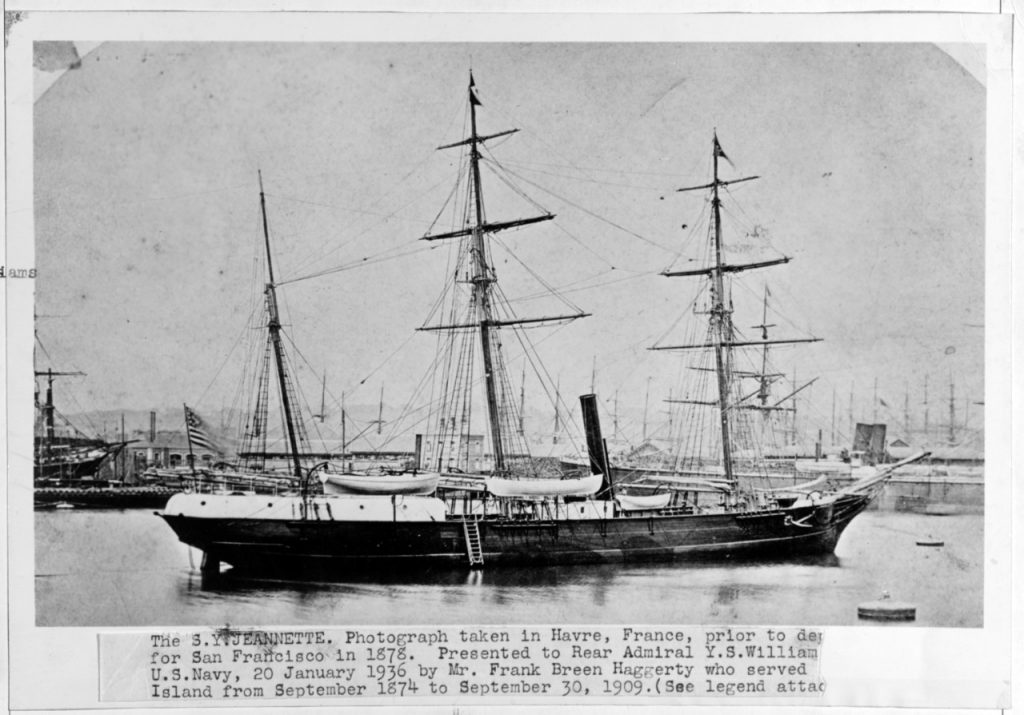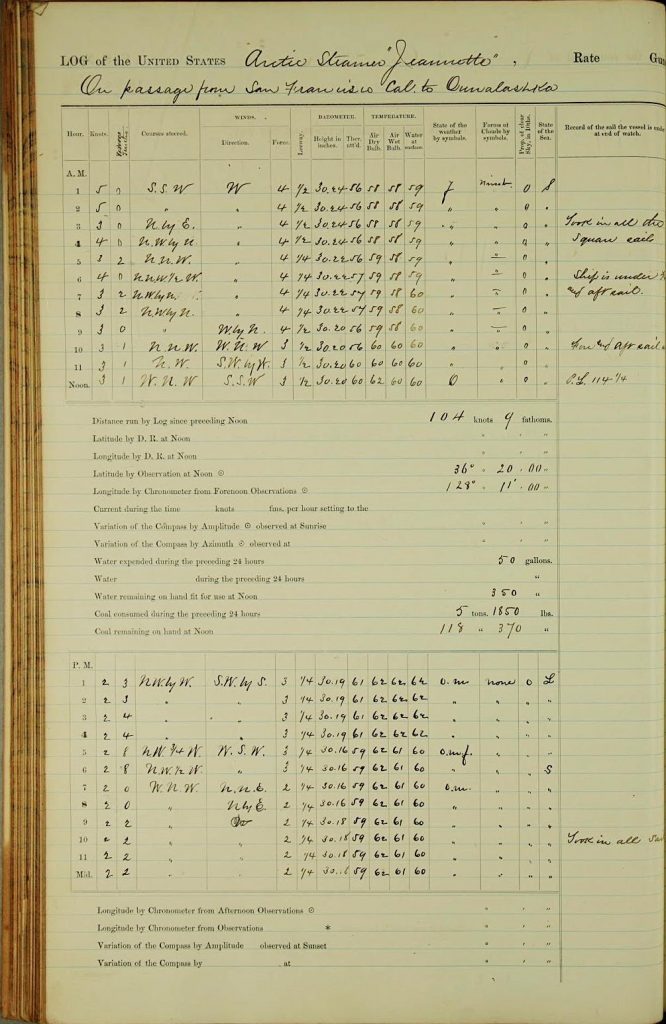Contents:
The Great Unknown
The Popularity of the Polar Question
America’s Second Attempt to Reach the North Pole
“Abandon Ship!”
Lives Were Lost, but the Logbooks Were Saved
Impact—Yesterday and Today
Appendix I
Appendix II
Appendix III
Annotated Bibliography
Flora Ranis
National History Day
Their only hope was a place with a reputation for hopelessness
—Historian, Hampton Sides (Kingdom 231)
As is true of all historical events, the end of the USS Jeannette is already known—the ship sank on June 13, 1881 without reaching its target of the North Pole. While the Jeannette made headlines in the late 1800s, few today know the story behind the men and their mission to explore and encounter one of the Earth’s last unknown regions and to exchange that knowledge with the world. Even though the ship failed to meet its formal objective, the men who volunteered for the mission accomplished much, and most sacrificed their lives to do so. The crew of the Jeannette were among the first to encounter and meticulously record the physical attributes of the Arctic, producing rare and valuable data. Nearly 140 years later, scientific organizations worldwide are exchanging the data from the Jeannette’s logbooks in order to better understand environmental changes in the polar region and improve global climate models.
The Great Unknown
Two hundred years ago, less was known about the North Pole than about Mars (Vaillant). In characteristic American spirit, the country yearned to learn what lay at the top of the world (Brooks). Was the North Pole “ice or land or sea . . . was [it] warm or cold . . . [was] it desolate or inhabited?” (Sides 19). Questions about the North Pole became the focus of politicians, professors, and the public:
How would man reach the North Pole . . . were there open sea routes? Unknown species of fish and animals? . . . Lost civilizations . . . whirlpools that led to the [center] of the earth? Were woolly mammoths and other prehistoric creatures still wandering the Arctic? (Sides 10)
In 1867, President Andrew Johnson approved the purchase of Alaska from Russia. Shortly thereafter, in 1869, construction of the Transcontinental Railroad was completed, and with it came the view that the nation’s exploration and expansion westward was likewise complete (Harris). As a result, the nation turned its attention to the next unexplored region. Manifest Destiny reached the Pacific Ocean and took a right turn northward (Sides). America officially began the race to the North Pole with the launch of the Polaris in 1871. However, the Polaris never reached the pole. Instead, the ship ran aground near Greenland after its commander was murdered (Henderson). This setback only fed the mystery surrounding the Arctic and further fueled the country’s desire to explore the North Pole. Britain launched its first expedition five years later, followed by missions from the Austro-Hungarian Empire, France, Germany, Italy, Russia, and Sweden (Harris). The race to the pole was on!
With the country’s thirst for exploration never fully quenched, the Arctic became the next natural target (Henderson). In addition, being the first country to reach the North Pole had become a national aspiration that served to unite the country following the divisiveness and scarring of the Civil War (1861-1865). Furthermore, for the American experiment to be successful and for American exceptionalism to be manifest, both would require U.S. prominence on the world stage. Being the first nation to reach the North Pole would send the world a message that the U.S. was a strong and consequential leader among nations (Cox).
The Popularity of the Polar Question
As the nation yearned for solidarity and stature, James Gordon Bennett Jr., the wealthy American owner of the New York Herald, yearned for subscribers. Bennett was well known for creating the news he reported and pulling extravagant publicity stunts. For example, in 1869, Bennett sent Herald reporter Henry Morton Stanley to Africa in search of Dr. David Livingstone. A British explorer and missionary, Livingstone had sailed to the continent in search of the source of the Nile River but disappeared (Dugard). Bennett hoped to profit from the mystery and to demonstrate American superiority by locating the missing British explorer. His plan worked.
Now, Bennett wanted to capitalize on the country’s interest in the Arctic (Danner). He personally funded the Jeannette—buying the ship; paying to outfit the vessel for Arctic travel; and stocking it with provisions, weapons, and equipment. Although privately funded, it was officially commissioned as a U.S. Navy ship. Bennett also embedded a reporter among the crew, hoping news sent back to the Herald about the ship’s Arctic encounters would make his newspaper’s circulation soar.
America’s Second Attempt to Reach the North Pole
The Jeannette (see Appendix I) set sail on July 8, 1879 from San Francisco en route to the North Pole (Sherwood). Thirty-two 1 men were aboard, with Commander George Washington De Long USN at the helm (Worral). At the docks, “more than ten thousand people” (Sides 134) came out to cheer on the expedition that carried “the good wishes of every American” (“American Arctic Expedition” 5). “The Jeannette carried the aspirations of a young republic burning to become a world power” (Sides 128).
The diverse crew of the Jeannette were hailed in the press as representing the best in “American originality, energy, courage and openhandedness” (“American Arctic Expedition” 5). These men were willing to exchange their lives for the glory associated with being the first to reach the North Pole (Gilder). Among the crew were civilian scientists who documented their experiences, sampled the waters below, diagramed the skies above, preserved local animal species, and measured the air currents (De Long).
When the Jeannette left port in 1879, the ship not only symbolized the hope of the nation, but it carried in its hull the latest and greatest in American ingenuity. To facilitate the crew’s collection of data, among other things, the ship was equipped with an observatory, darkroom, desalination distiller, current trackers, wind trackers, magnetic and meteorological instruments, arc lamps (Thomas Edison’s precursor to the light bulb), and Alexander Graham Bell’s newly invented telephones. For the duration of the trip, the crew “hacked holes in the sea ice to take studious measurements of ocean depth, current, salinity, specific gravity, and temperature” (Sides 162). It was these detailed measurements recorded in the ship’s logs and saved from the sinking ship that definitively disproved the then-prevalent notion that there existed an open sea to the North Pole (Ambler).
However, the ship’s quest for glory was soon hindered by the harsh realities of the Arctic. Shortly after entering the waters of the Arctic Ocean, the Jeannette encountered massive floating slabs of ice (called floes). In some places, the ice over the water reached a depth of fifteen feet:
The men felt a new pressure working on the starboard side, and then suddenly a large floe shoved the Jeannette onto a shelf of ice, causing her to list crazily. Other floes tightened around the ship. Under the pressure, her timbers began to tick and groan. Within minutes, the Jeannette was completely imprisoned. (Sides 152)
At sea for less than two weeks, after leaving her last port in Siberia, the Jeannette became stuck in the ice and remained so for nearly two years. During this period, the ship’s crew endured freezing winter months without natural or man-made light as Edison’s lamps did not work in the severe conditions of the Arctic. In spite of the harsh environment, they continued to collect data on the unique Arctic conditions they encountered. The ice’s stranglehold also meant an end to any news of the Jeannette, since there was no way for the crew to communicate their status with the outside world. As a result, the country grew restless to hear about its heroes. In 1881, President James Garfield sent three American ships (USS Alliance, USS Corwin, and USS Rodgers) to find the Jeannette. However, not one encountered any more than a whisper of information regarding the lost ship.
“Abandon Ship!”
After nearly two years stuck in the ice, on June 12, 1881, the USS Jeannette finally succumbed and began to sink (Muir). The crew abandoned ship, taking boats, sleds, all the provisions they could carry, and the ship’s logbooks with them. For the next two months, they trudged over snow and slush, hoping to encounter open water so they could sail their boats to solid land and an inhabited village (Harris). It was an experience that would test the crew beyond anything they had encountered before:
Some men suffered frequent convulsions. Others seemed to be veering toward madness. Thirst and hunger were constant companions. Their tents leaked. Their furs stank. Their squishy boots oozed cold seawater . . . many of the men could no longer pull. Some couldn’t walk. A few couldn’t even stand. (Sides 267)
Eventually, the men did reach solid ground. Commander De Long named the territory Bennett Island and declared it part of America. Today, Russian maps list it as Ostrov Bennetta (Sides). While there were no people there to facilitate the crew’s rescue, the island did afford the men an opportunity to hunt, regain their strength, and repair their boats (Sides). However, Commander De Long knew they could not survive an Arctic winter on the island so after a week, they departed and headed south. With three boats in their possession and open waters ahead, the remaining crew divided into three groups and set sail. Within hours, they had lost sight of each other (De Long).
Lives Were Lost, but the Logbooks Were Saved
Commander De Long and the thirteen crewmen on his boat made it to land and came across two abandoned, primitive hunting camps. In spite of the hardships and the crew’s terrible condition, not once did De Long allow the ship’s logbooks to be lost or forgotten. With the crew at their physical and mental limit, De Long sent the two most capable men ahead to hunt for game; if no game was found, they were to continue on until they found people to help mount a rescue. After a week of additional hardship, the two men stumbled upon a native Yakut (the indigenous people of northeast Siberia), who took them to his remote village (Melville). From there, they were taken to the Russian settlement of Bulun, where they were unexpectedly reunited with a crewmember from one of the other two boats. In fact, all of the crew on this second boat had survived. The surviving crew launched a rescue mission, but Commander De Long’s group was not located for nearly five months; by then, all of the men were dead—found frozen in the ice (Melville). The men on the third boat were never found (Sherwood).
Throughout the entire journey, Commander De Long refused to abandon the ship’s logs, despite the hardship they brought the men:
They [the ship’s logbooks] were all that was left of the Jeannette’s expedition, the only record of their voyage and the only tangible proof of their exploratory and scientific accomplishments. He [De Long] would hold onto them at all costs—“as long as I have men to carry them.” (Sides 319)
Even when the men knew they themselves were past saving, they never gave up hope of saving the ship’s logs, and one of Commander De Long’s last acts was to drag the ship’s logs out of the reach of flood waters (Melville). The rescue mission, too late to save De Long and his crew, did locate the ship’s logs and return them to the U.S. (see Appendix II).
Impact—Yesterday and Today
The saga of the USS Jeannette inspired not only Americans, but people around the world. Exchanges between countries made the efforts to locate the ship and rescue the surviving crew possible (Moore). The Royal Danish Navy, Russian authorities, and Great Britain’s Colonial Department all alerted their trappers, traders, sea captains, and navy personnel to keep a lookout for the Jeannette. Of the international rescue effort, the New York Herald published, “this will be a universal search of the whole border of the ‘unknown region,’ participated in by nearly all the civilized nations of the earth” (Sides 342). In addition, the support provided by the Russian government was central to the safe return of the remaining crew and to the retrieval of the Jeannette’s logs with their valuable data. When the Americans asked for help, the Russians replied, “You have the whole Russian nation at your back” (Sides 378).
Today, researchers and scientific organizations, both home and abroad, are exchanging the measurements and observations collected by historical ships, such as the Jeannette, in order to improve weather and climate prediction models and the algorithms that merge the data in these models (Compo). Weather and climate models are critical because they help us “estimate the risk of extreme weather” (Compo), which can devastate crops and lead to loss of life, and “estimate how altering the composition of the atmosphere . . . could alter the climate and associated weather out several decades to centuries from now” (Compo). Recently, all of the Jeannette’s handwritten logs were manually transcribed and entered into the International Comprehensive Ocean-Atmospheric Data Set (Hickey; see Appendix III) and the 20th Century Reanalysis Project (Compo). The Jeannette‘s logbooks are unique because they fill two gaps in the research. First, the logbooks from the Jeannette provide data on the Arctic, which is an area that is still largely unknown (Setzer). Second, most data on the Arctic are collected during the summer months when safe passage is more likely, but the data from the Jeannette‘s logbooks were collected year round and therefore provide a more complete picture of the Arctic (Isaacson). The data from the saved logbooks of the Jeannette and other historical ships “allow scientists to reconstruct weather patterns and extremes from the past” (Allan para 3), and understanding what the weather was like in the past is vital to understanding what the world will be like in the future.
Thirty-three men set sail on the Jeannette, but only thirteen returned alive three years later (Cox). What these men encountered, endured, and overcame in their quest to explore uncharted regions represents not only what is great about America’s exploratory vision, but what is great about the human spirit. The harsh Arctic conditions the crew encountered and their incorrect hypothesis of what existed at the pole ultimately defeated them. 2 In spite of this, they made significant contributions to numerous fields. The Jeannette explored and detailed hundreds of miles of earth that no person had seen before, adding to our understanding of the geography, oceanography, and meteorology of the Arctic. They documented that the ice cap was not stationary, found that the ice pack was not a source of freshwater, and dispelled the open polar sea theory. In addition, the extensive data from the expedition are being exchanged in new ways today, helping scientists around the world predict weather events, including the impact and pace of global warming (Meier). The men on board the Jeannette risked everything to explore and encounter one of the last unknown regions and exchange that knowledge with the world. Not all of the men on board the USS Jeannette came home alive, but they all returned heroes.
Appendix I

Photograph of the USS Jeannette. Source: Log Books of the United States Navy, 19th and 20th Centuries. (2014). Retrieved from http://www.naval-history.net/OW-US/Jeannette/USS_ Jeannette.htm
Appendix II

Handwritten page with meteorological data from a logbook of the USS Jeannette. Source:
http:IIoldweather.s3.amazonaws.comlow31final/USS%20Jeannettelvol001of0041vo1001_
042 0.jpg
Appendix III
Location | Place Name | Name = On passage from San Francisco Cal. to Ounalashka

Location | Observed | Latitude = 36 20 | Longitude = 128 11

A transcribed page from a logbook of the USS Jeannette that was entered into international databases. Source: Welcome Aboard the USS Jeannette. Retrieved from http://forum.oldweather. org/index.php?topic=3322.0
Annotated Bibliography
To view the full annotated bibliography for this paper, download it here: Annotated Bibliography
(Return to August 2016 Table of Contents)
Footnotes
- In Alaska, De Long hired two local Inuits to help care for the forty sled dogs brought aboard, and near the Bering Strait, he sent the ship’s cabin boy home on the Jeannette’s coal tender, leaving thirty-three crew on the Jeannette when it made its final departure for the North Pole. ↩
- It would be another thirty years before humankind would reach the North Pole. Although Cook claimed to have reached the pole in 1908, he was later discredited, and Peary (an American) is recognized today as the first to reach the North Pole in 1909. ↩
